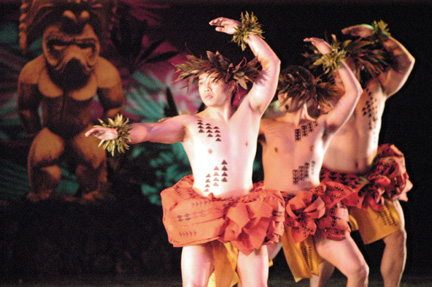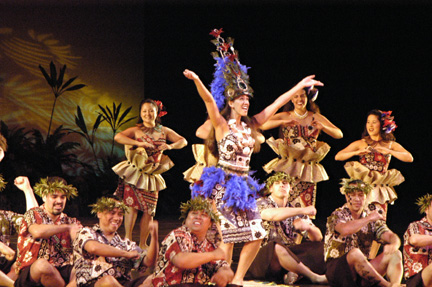Living the Hula Life
A
Feast of Hula
Na Lei Hulu I Ka Wekiu
Lincoln Center Out of Doors
Damrosch Park
August 15, 2004
By
Susan Reiter
copyright
© 2004 by Susan Reiter
published August 23, 2004
 New
York offers a plethora of dance events covering all styles and ethnicities,
but an opportunity to view an evening of hula is a rarity, ad was well
worth venturing out on humid, threatening evening. The annual Lincoln
Center Out of Doors festival, which this year is emphasizing artists who
represent the Pacific Rim, offered the East Coast debut of Na Lei Hula
I ka Wekiu, a 41-member San Francisco-based Hula troupe founded in 1985.
The company's name translates as "the many-feathered wreaths at the
summit, held in high esteem," and the poetry and imagery of the name
seemed appropriate as the evening progressed and the director/choreographer
Patrick Makuakane elucidated some of the themes and traditions of Hula
during his engaging introductions to the different pieces.
New
York offers a plethora of dance events covering all styles and ethnicities,
but an opportunity to view an evening of hula is a rarity, ad was well
worth venturing out on humid, threatening evening. The annual Lincoln
Center Out of Doors festival, which this year is emphasizing artists who
represent the Pacific Rim, offered the East Coast debut of Na Lei Hula
I ka Wekiu, a 41-member San Francisco-based Hula troupe founded in 1985.
The company's name translates as "the many-feathered wreaths at the
summit, held in high esteem," and the poetry and imagery of the name
seemed appropriate as the evening progressed and the director/choreographer
Patrick Makuakane elucidated some of the themes and traditions of Hula
during his engaging introductions to the different pieces.
Whatever naïve, uninformed and definitely sketchy sense I had of what Hula is before seeing this performance, it was thrillingly challenged and assaulted during the first four numbers. The full company—eight men and about 30 women, with bodies ranging form svelte to ample—poured onto the stage in thick, short bunchy skirts. The women wore black midriff tops and their hair was loose; the men were bare-chested, and all wore leis around their neck and wreaths on their heads. The ensemble intoned an invigorating chant, accompanied by simple, earthy movements, and then the men took center stage and performed in unison, their sturdy, earthy movement somehow incorporating a subtle, gentle sensuality.
 According
to the program, their dance concerned "ancient bird catchers in search
of ornamental feathers."
According
to the program, their dance concerned "ancient bird catchers in search
of ornamental feathers."
Then it was the women's turn, and the sheer power of the large, vivid ensemble and the generosity and joy with which they performed was truly invigorating. Accompanied by the dry but evocative traditional melody performed by three excellent musicians who were wedged into an upstage corner, their grounded undulations set off the fluid, purposeful upper body and arm movements that hinted at subtle meanings without becoming literal. The full company then performed a vibrant chant, accompanied by gourds shaped like an oblong figure-eight, while moving in unison through curving, sensuous phrases.
Mr. Makuakane, who exudes enthusiasm and knowledge about Hula and clearly enjoys sharing and expanding its traditions, took the stage and introduced his group by saying "we are a bunch of Hawaiians living the hula life in San Francisco." He assured us that he had offered a chant to ward off any potential rainfall, then promised that the program would include "the traditional and not-so-traditional, and everything in between" and proceeded to make good on that promise.
As he explained more fully during an exuberant and informative August 17th lecture-demonstration (featuring six company members) at the Library and Museum for the Performing Arts at Lincoln Center, these initial numbers on the program exemplify "Hula Kahiko," the traditional, ancient style, rooted in ceremony and ritual and accompanied by chant, poetry and percussion. The hand and foot movements of the dances embellish but do not illustrate the poetry; they don't have their own meaning per se, he explained. What came across most strongly was communicativeness and focused power of these dances, as well as the way the dancers delight in their weight and celebrate the body's curves and the sensuality of the flesh. The direct, visceral forces of these traditional hula pieces, performed by massed forces, immediately erased my associations of hula with sweetly swaying, decorative prettiness.
The program also offered several examples of "Hula auana," which Mr. Makuakane described in the lecture-demonstration as a style "that drifted and wandered away from the ceremony and ritual" and features additional musical elements, such as the ukelele. The "Hilo Medley" offered both men and women dancing in this more relaxed, fluid style, and its opening portion, in which eight women backed up an ample, ripely sensual leader wearing a large orange dress, epitomized its flowing continuity, sweetly sexy undulations. The effortless, continuous rippling movements of the hands and arms were evocative but rarely literal. A couple of company members who are actual members of the San Francisco Fire Department performed a witty, light-hearted "Firemen's Hula" that Mr. Makuakane jokingly introduced as having a "long tradition" behind it. As their legs traced out the bouncy, repetitive rhythms of a buoyant Hawaiian song, the duo cheerfully included such gestures as climbing a ladder and throwing a fire hose into the ongoing weave of upper-body movements.
 Mr.
Makuakane's contribution to the hula style is known as "hula mua,"
and it applies the hula vocabulary to a range of contemporary music. Based
on the evidence on this program (and the lecture-demonstration's closing
number set to "I left my Heart in San Francisco"), the musical
choices can be contemplative and romantic, or irreverent. Several languid
female vocals were the basis for these dances: "I'll Remember You"
offered seven willowy women in long, floral sheaths whose gentle swaying
was punctuated by warm, enveloping gestures of generosity and sharing.
Etta James' soulful, intense rendering of "At Last" occasioned
a rather bland female solo in a glittery sheath; its prettiness lapsed
into dullness before the song was over. "A Love Trilogy," in
which this approach, with its focus on willowy female lyricism, was overextended,
but featured an unlikely gem at its core: the full female ensemble, rooted
in place wearing simple long black dresses, somehow embodying with every
fiber of their beings the heartfelt emotion of Roberta Flack's rendition
of "The First Time Ever I Saw Your Face." What might have become
hokey became, in its unison energy and tactful restraint, its own form
of poetry.
Mr.
Makuakane's contribution to the hula style is known as "hula mua,"
and it applies the hula vocabulary to a range of contemporary music. Based
on the evidence on this program (and the lecture-demonstration's closing
number set to "I left my Heart in San Francisco"), the musical
choices can be contemplative and romantic, or irreverent. Several languid
female vocals were the basis for these dances: "I'll Remember You"
offered seven willowy women in long, floral sheaths whose gentle swaying
was punctuated by warm, enveloping gestures of generosity and sharing.
Etta James' soulful, intense rendering of "At Last" occasioned
a rather bland female solo in a glittery sheath; its prettiness lapsed
into dullness before the song was over. "A Love Trilogy," in
which this approach, with its focus on willowy female lyricism, was overextended,
but featured an unlikely gem at its core: the full female ensemble, rooted
in place wearing simple long black dresses, somehow embodying with every
fiber of their beings the heartfelt emotion of Roberta Flack's rendition
of "The First Time Ever I Saw Your Face." What might have become
hokey became, in its unison energy and tactful restraint, its own form
of poetry.
Mr. Makuakane's witty, teasing side was evident in a "Tribute to Hawaii's first radio station," in which the dancers' arms shaped the stations' call letters, and a rodeo number that gave the men, stepping and swaying in cowboy hats, some equal time after the languid feminine emphasis of the trilogy. He also staged his own personal attack on the cliched grass-skirt image of airline commercials by having the men, in tough-guy head gear, muscle shirts and grass skirts worn over pants, strutted to angry-sounding techno music. His ideas are plentiful, but some of the selections tended to drift off rather than actually come to a close.
The scheduled second performance of "A Feast of Hula" was unfortunately rained out, thus cutting in half the number of potential audience members who might have seen this unusual, vibrant company. The unmannered delight and enthusiasm with which they perform was a real treat, as was the opportunity for exposure to the rich possibilities of hula. The program was a welcome discovery and an invitation to explore more fully the richness of the tradition. Mr. Makuakane (who became the fourth—and at times solo—musician for some of the numbers, and also chanted powerfully) brings a thorough knowledge of the Hula tradition is an ideal, articulate guide into this arena. Whatever new directions and musical explorations he has in mind for the art form whose history he understands and cherishes, one hopes he will always keep a place for the "Hula Kahiko" that speaks with such force and truth.
Originally
published:
www.danceviewtimes.com
Volume 2, No. 32
August 23, 2004
Copyright
©2004 by Susan Reiter
|
|
|